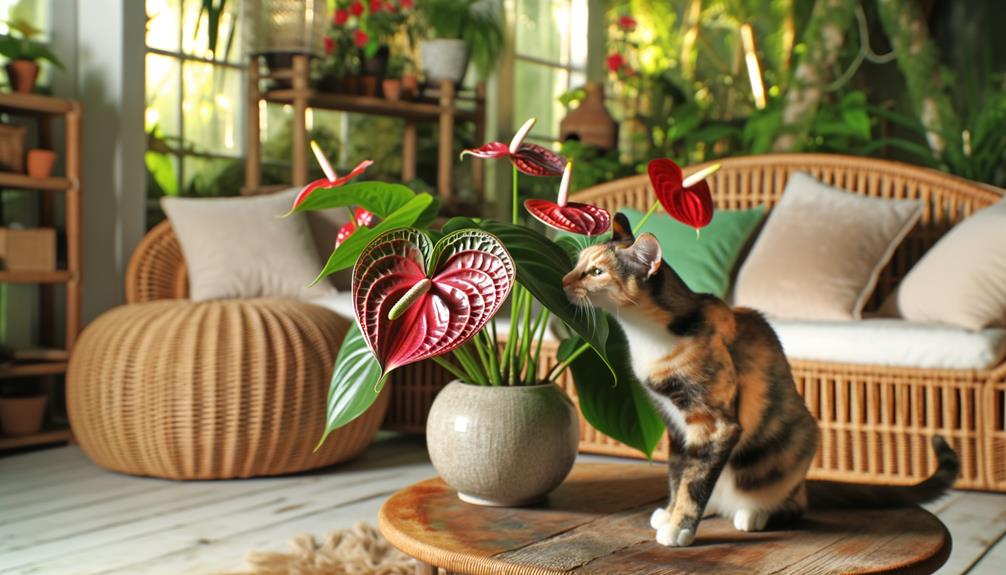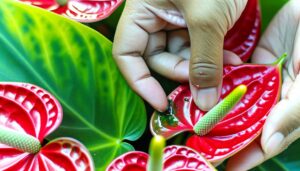Is Anthurium Safe for Cats?
No, Anthurium plants aren't safe for cats. They contain insoluble calcium oxalate crystals, which cause severe oral irritation, pain, and gastrointestinal distress.
Immediate symptoms include drooling, pawing at the mouth, and difficulty swallowing. More serious issues like vomiting, diarrhea, and respiratory problems can develop if ingested.
If your cat has interaction with an Anthurium plant, you should wipe its mouth with water and contact a vet right away. Opt for pet-safe alternatives like Spider Plants or Areca Palms to keep your cat healthy and your home serene.
To learn about prevention and care tips, keep going.

Key Takeaways
- Anthuriums are toxic to cats due to insoluble calcium oxalate crystals.
- Ingestion causes severe oral irritation, pain, and gastrointestinal distress.
- Common symptoms include drooling, vomiting, and difficulty swallowing.
- Immediate veterinary care is essential for effective treatment and recovery.
- Opt for safe plants like Spider Plants or Boston Ferns as alternatives.
Anthurium Toxicity
Anthuriums contain insoluble calcium oxalate crystals that can cause severe oral irritation and gastrointestinal distress in cats. When your cat chews on an Anthurium, these needle-like crystals are released, embedding into the oral tissues. This mechanical irritation can lead to intense pain and swelling.
Additionally, calcium oxalate crystals aren't soluble, meaning they don't dissolve in water, making them persistently irritating. When ingested, they continue to cause problems as they travel through the gastrointestinal tract, potentially leading to more severe distress.
Understanding this mechanism is essential for cat owners because it highlights the inherent risk posed by Anthuriums. Preventing exposure is vital to make sure your cat remains safe from these harmful effects.
Symptoms of Poisoning
When your cat consumes parts of an Anthurium plant, you may notice immediate symptoms such as drooling, pawing at the mouth, and difficulty swallowing. These reactions occur because Anthurium contains insoluble calcium oxalate crystals that irritate the mucous membranes.
Common symptoms include:
- Oral discomfort: Your cat may exhibit excessive drooling and signs of mouth pain.
- Gastrointestinal distress: Symptoms like vomiting and diarrhea often follow ingestion.
- Respiratory issues: Difficulty breathing and wheezing can occur if the airway is affected.
These symptoms are your cat's response to the plant's toxic compounds. Keep an eye out for these signs, as early detection is essential for effective treatment. Understanding these symptoms guarantees you can act promptly to safeguard your pet's health.
Immediate Actions
If you suspect your cat has ingested parts of an Anthurium plant, immediately remove any plant material from its mouth and rinse the area with water to reduce irritation. This step is vital as Anthurium contains calcium oxalate crystals that can cause severe irritation and discomfort.
Make sure you wash your hands thoroughly afterward to prevent any potential skin irritation. Monitor your cat closely for symptoms such as drooling, pawing at the mouth, or vomiting. Providing fresh water can help dilute any ingested toxins. Keep your cat calm to prevent further stress.
Taking these immediate actions can greatly lessen the plant's harmful effects while you prepare for further steps to safeguard your cat's safety and well-being.
Veterinary Care
Consulting a veterinarian promptly is vital to guarantee your cat receives appropriate care and treatment for potential Anthurium poisoning. Delaying can worsen symptoms, leading to severe health complications. Here's why immediate professional intervention matters:
- Accurate Diagnosis: Vets can differentiate between Anthurium poisoning and other conditions with similar symptoms, ensuring your cat gets the right treatment.
- Effective Treatment: Veterinarians can administer treatments like IV fluids, anti-nausea medications, and pain relief to alleviate symptoms and support recovery.
- Monitoring: Continuous monitoring by a vet ensures that your cat's condition is improving and allows for adjustments in treatment if necessary.
Prompt veterinary care is vital for mitigating risks and promoting your cat's swift recovery from potential Anthurium exposure.
Safe Alternatives
Several pet-safe plants can be excellent alternatives to Anthuriums, safeguarding your home remains both beautiful and cat-friendly.
For instance, Spider Plants (Chlorophytum comosum) are non-toxic and have air-purifying qualities.
Boston Ferns (Nephrolepis exaltata) are another safe choice, thriving in indirect light and adding lush greenery.
If you prefer flowering plants, African Violets (Saintpaulia) offer vibrant blooms without posing a risk to your feline friends.
Additionally, Areca Palms (Dypsis lutescens) provide a tropical feel and are safe for cats.
These alternatives not only enhance your indoor environment but also protect the safety and well-being of your pets.
Conclusion
Imagine your cat is a curious explorer, always on a new adventure. Just as you wouldn't let them wander a dangerous jungle, you should keep them away from toxic plants like anthurium.
Even a small nibble can lead to severe health issues. Instead, opt for cat-safe plants like spider plants or Boston ferns.
Safeguarding your feline friend guarantees their adventures remain safe and joyful, reflecting your dedication to their well-being.






